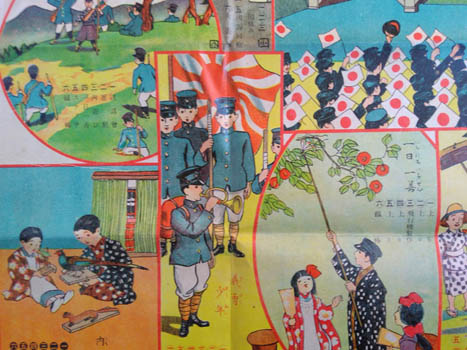
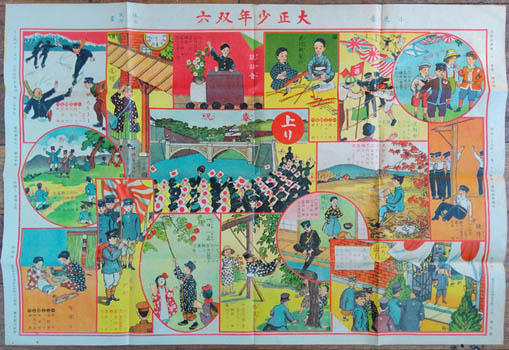
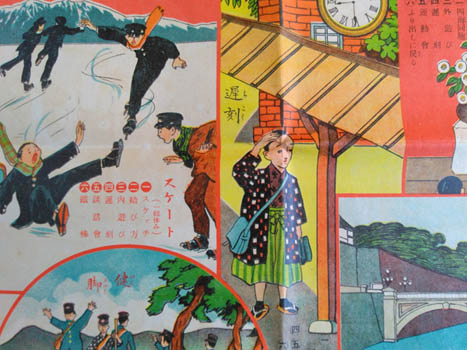
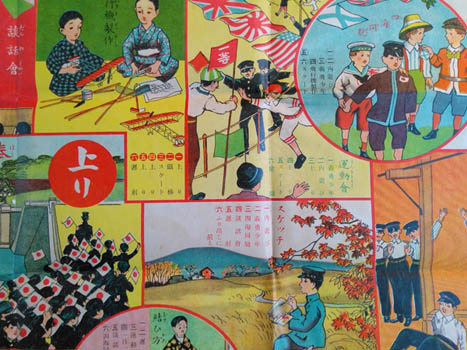

Kobayashi Eijiro. [Taisho Shonen Sugoroku]. Tokyo, Shonen Sekai 1915 (Taisho 4). Colour broadside 54x79cm. A touch browned and minor signs of use; pretty good. Au$250
A gift from the boys' magazine Shonen Sekai and, as always with boys' sugoroku, packed with excitement and adventure. Girls sometimes get to watch in awe.
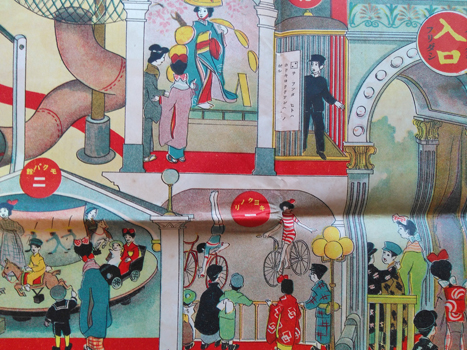
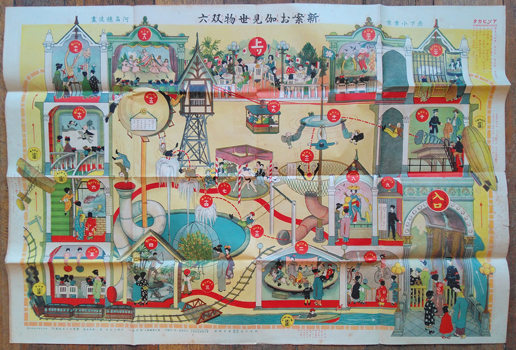
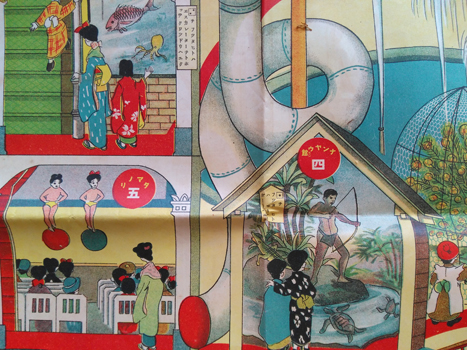
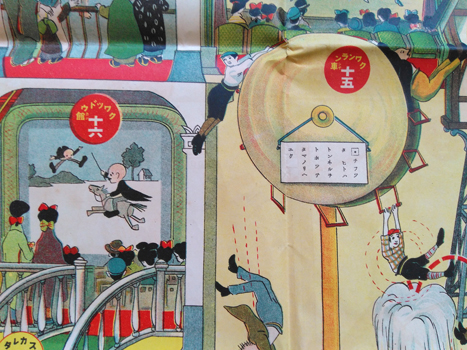

Kawabata Honami [Shin'an Otogi Misemono Sugoroku]. Tokyo, Yonen no Tomo 1916 (Taisho 5). Colour broadside 53x78cm. Edges nibbled, some browning and a couple of small flaws but pretty good. Au$485
This utopian view of a kids' paradise was the New Year gift from the magazine Yonen no Tomo. It's hard to find. This is a model for a new kind of fun palace that has a lot in common with the modern department store, which usually had fun for kids and a cafe at the top. In this case all the boring stuff - like clothes - has been stripped out and the whole emporium turned over to fun.
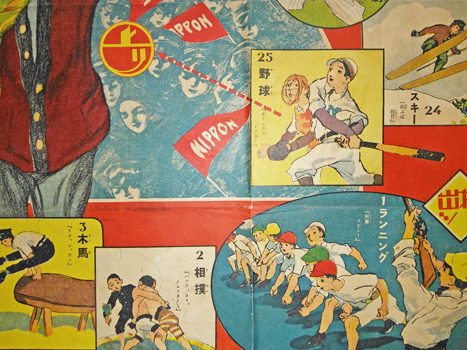
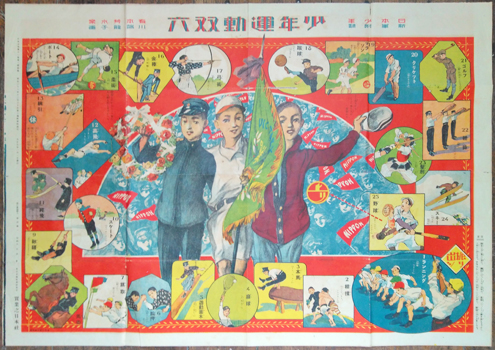
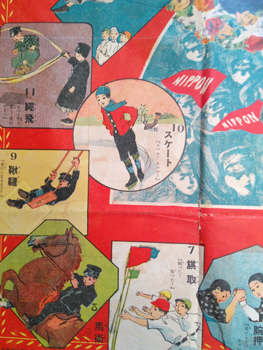
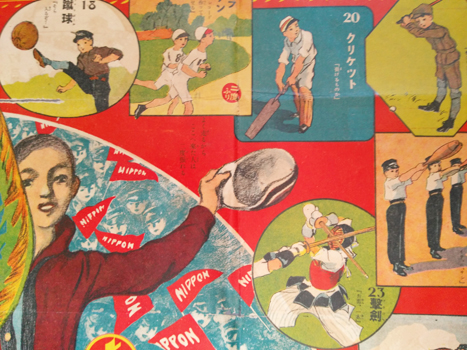

Sugoroku. Kawabata Ryushi. [Shonen Undo Sugoroku]. Tokyo, 1916 (Taisho 5). Colour printed broadside 54x79cm. Some separations along folds with some proper repairs. An ok copy. Au$125
The New Year gift from the magazine Nihon Shonen - Japanese Boy. A splendid vision of the life of the active, enthusiastic Japanese boy: success and fame. Compare this with contemporary sugoroku for girls.
Kawabata's career took a curious turn during a 1913 stay in America to study western painting. Apparently he was so impressed with the Japanese art he saw in Boston he switched to being a Nihonga painter. Still, he remained being an illustrator for magazines for quite some time. As did most of the early to mid 20th century artists now revered.
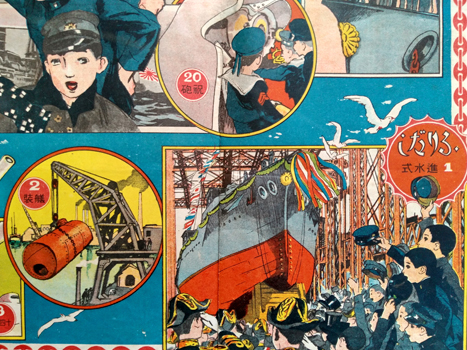
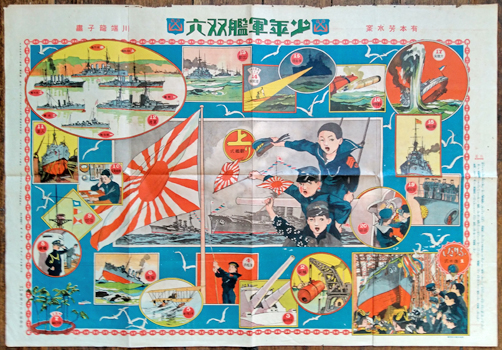
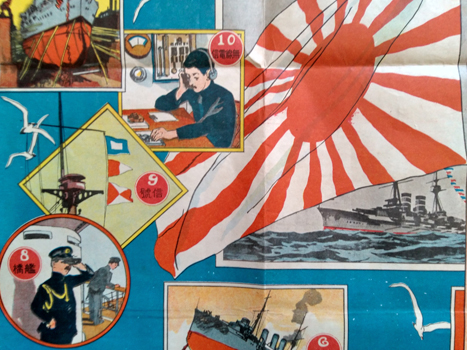
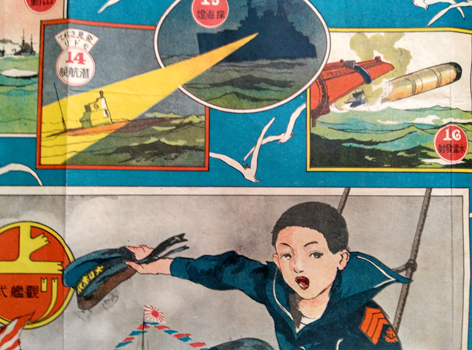

Kawabata Ryushi. [Shonen Gunkan Sugoroku]. Tokyo,Nihon Shonen 1917 (Taisho 6) 54x78cm colour broadside. Top edge nibbled, minor signs of use. Au$425
A boy's celebration of the navy; this game was the new year gift from the magazine Nihon Shonen.
Kawabata's career took a curious turn during a 1913 stay in America to study western painting. Apparently he was so impressed with the Japanese art he saw in Boston he switched to being a Nihonga painter. Still, he remained being an illustrator for magazines for quite some time. As did most of the early to mid 20th century artists now revered.
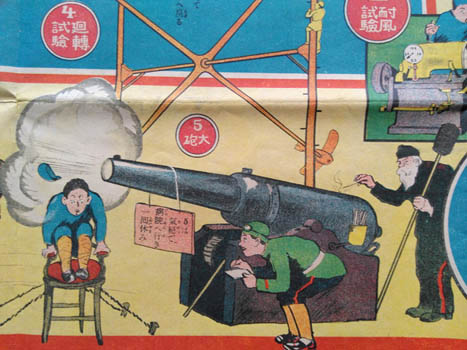
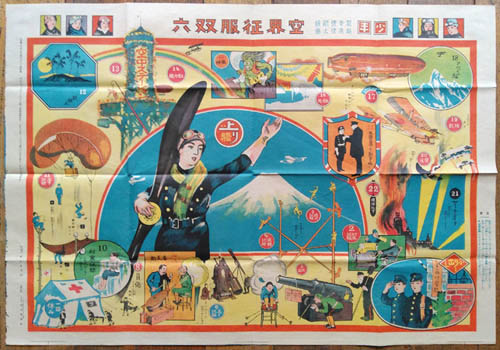
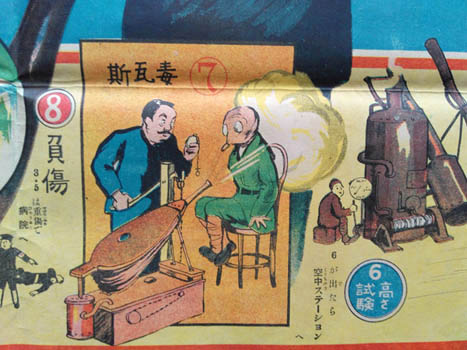
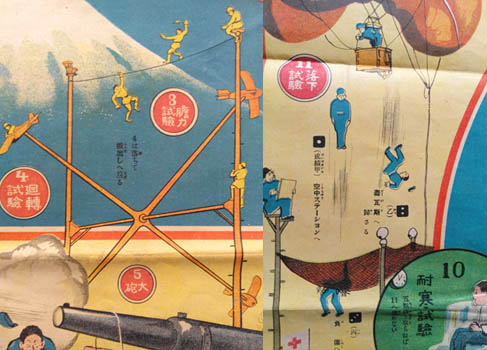

Fujiwara Ritsuta. [Sorakai Seifuku Sugoroku]. Tokyo, Shonen 1918 (Taisho 7). Colour broadside 79x55cm. A nice copy. Au$480
A delight - the rigours of flying school explained with the careful attention to truth and detail of a Heath Robinson. This was the new year gift from the magazine Shonen.
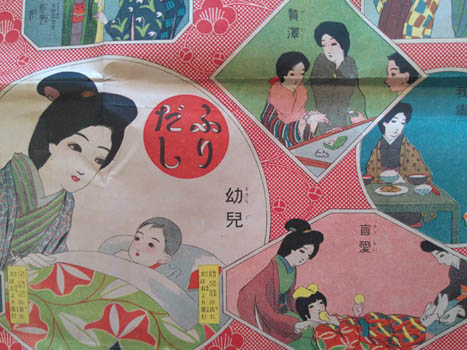
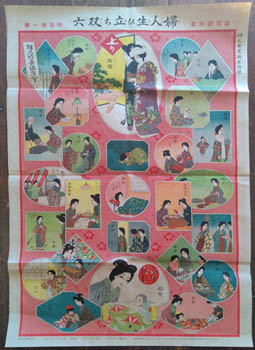
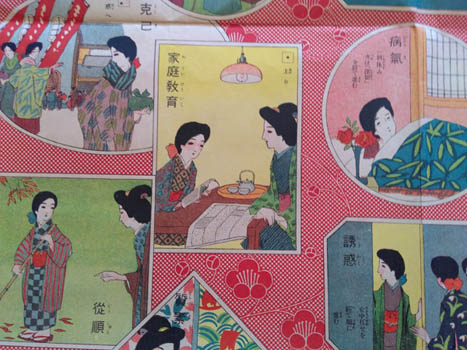
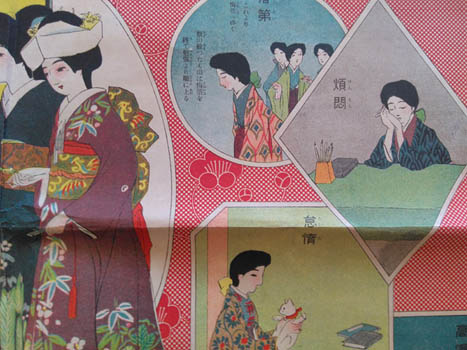

Akashi Seiichi. [Fujin Nama Hi Tate Sugoroku]. Tokyo, Fujin Sekai 1918 (Taisho 7). Colour broadside 78x54cm. A bit of unnecessary folding, quite a good copy. Au$220
A fortunate life for a girl from cradle to bride. She must have opened her mouth and said something during these years but as she is well brought up we never see her lips move. This was the new year gift from the magazine Fujin Sekai - Woman's World.
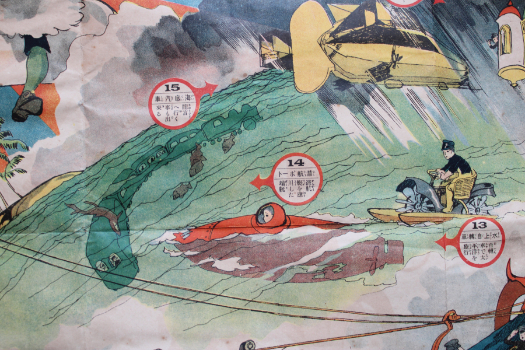
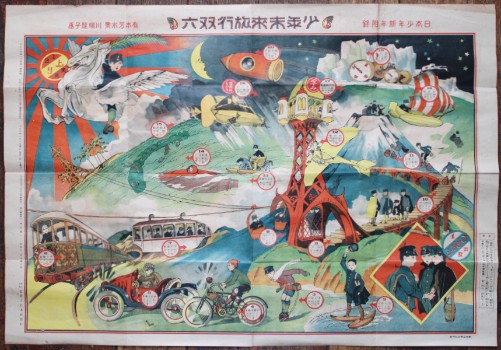
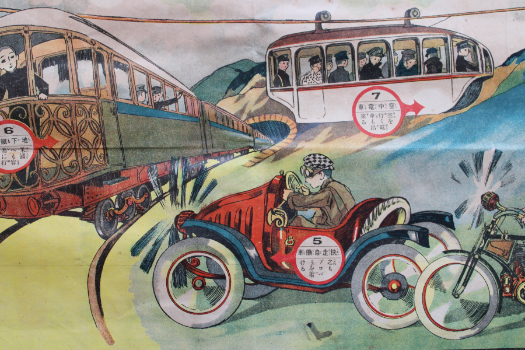
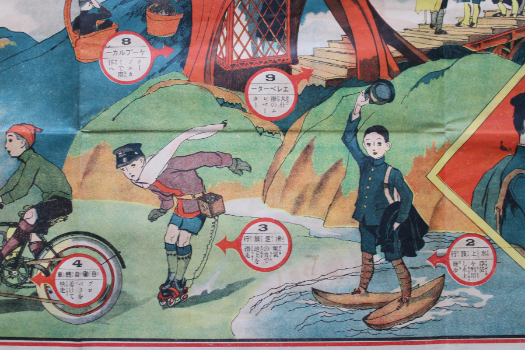

Sugoroku. Kawabata Ryushi. [Shonen Mirai Ryoko Sugoroku]. Tokyo, Nihon Shonen 1918 (Taisho 7). Colour broadside 78x54cm. Some browning and minor signs of use; not bad. Au$500
The New Year gift from the boy's magazine Nihon Shonen. A view of travel in the future, this is among my favourites of the travel adventure sugoroku and hard to find in anything like one piece. Doubtless it was a favourite with many others too.
Kawabata did several of the best, most captivating, sugoroku of the period. His career took a curious turn during a 1913 stay in America to study western painting. Apparently he was so impressed with the Japanese art he saw in Boston he switched to being a Nihonga painter. Still, he remained being an illustrator for magazines for quite some time. As did most of the early to mid 20th century artists now revered.
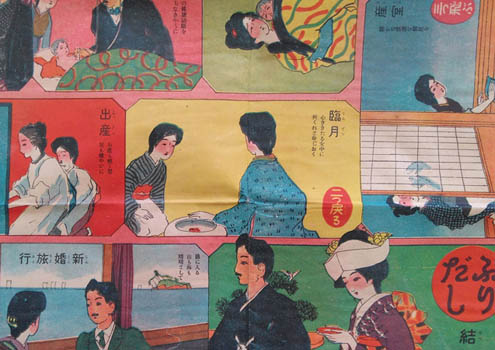
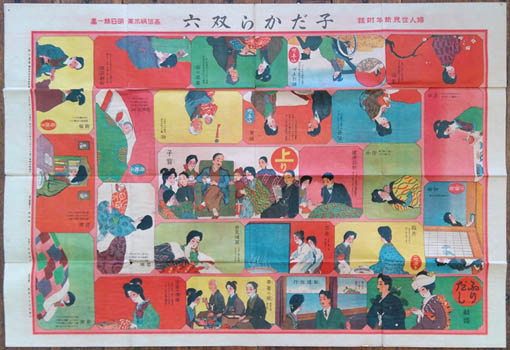
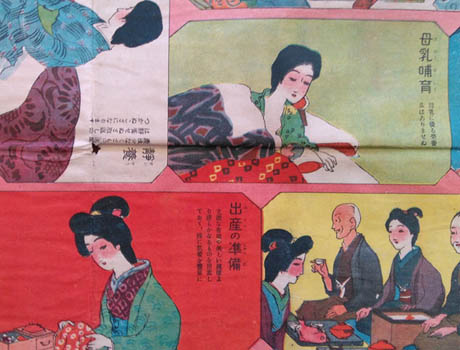
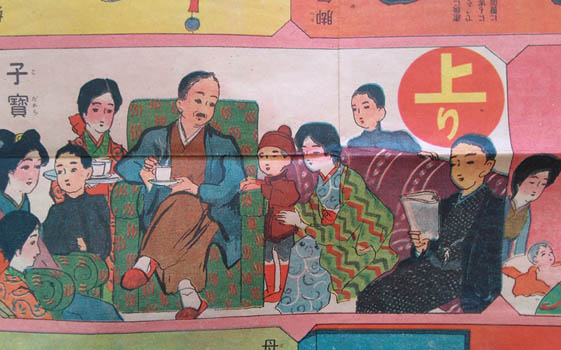

Akashi Seiichi. [Kodakara Sugoroku]. Tokyo, Fujin Sekai 1919 (Taisho 8). Colour printed broadsheet 54x79cm. A bit used, some browning and a couple of small holes in folds; pretty good. Au$300
The new year gift from the magazine Fujin Sekai - Woman's World - is a colourful hymn to the joys of having children.
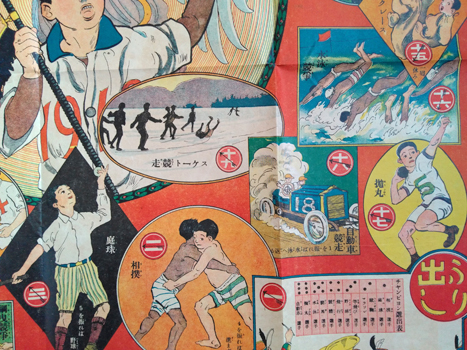
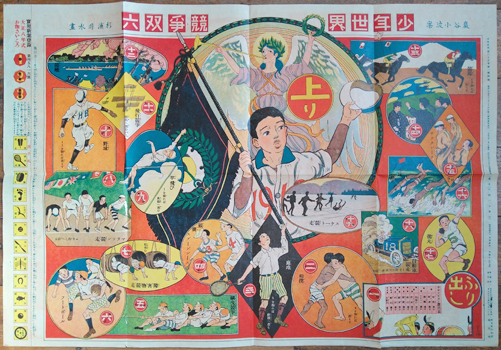
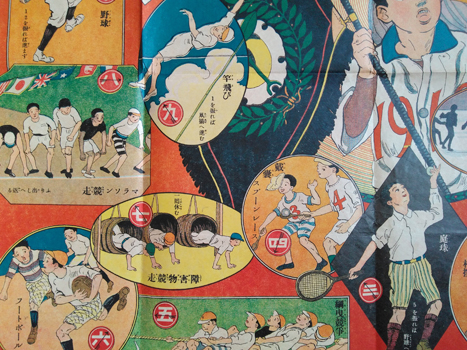
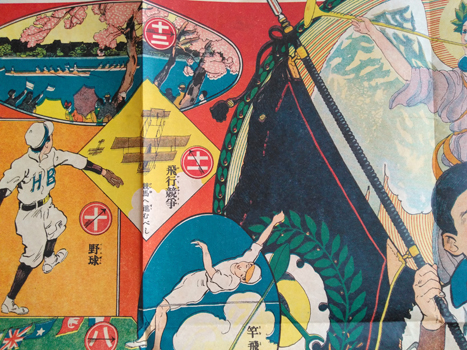

Sugiura Hisui. [Shonen Sekai Kyoso Sugoroku]. Tokyo, Shonen Sekai 1919 (Taisho 8). Colour broadside 54x78cm. A couple of small nicks in a margin; rather good with playing pieces intact in the left margin. Au$400
Sports, sports and more sports in this game - the new year gift from the boys' magazine Shonen Sekai. If you look at portraits of the champion of modern design and fastidious dandy, Sugiura, it's hard to imagine anyone less inclined to jump and sweat. But maybe I misjudge him.
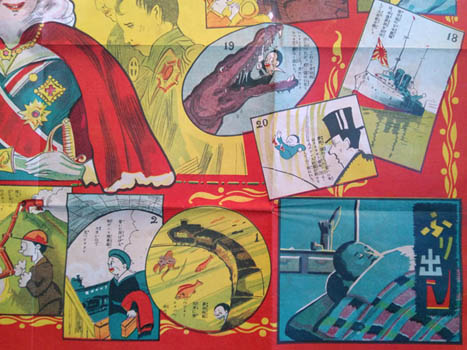
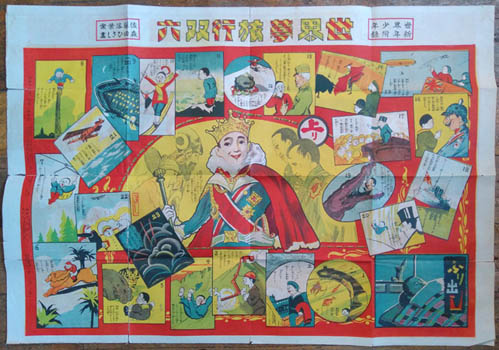
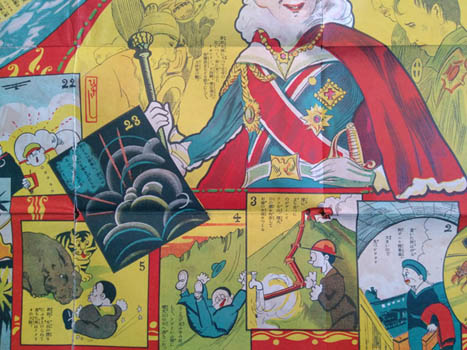
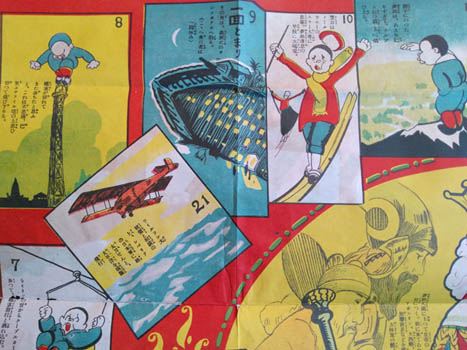

Morita Hisashi. [Sekai Yume Ryoko Sugoroku]. Tokyo, Sekai Shonen 1919 (Taisho 8). Colour broadside 79x54cm. Used with several tears in folds and an old repair. Au$100
A good sugoroku but not a great copy, this dream adventure was the new year gift from the boys' magazine Sekai Shonen. Morita was a busy illustrator and art director for the Takarazuka Revue through the twenties.
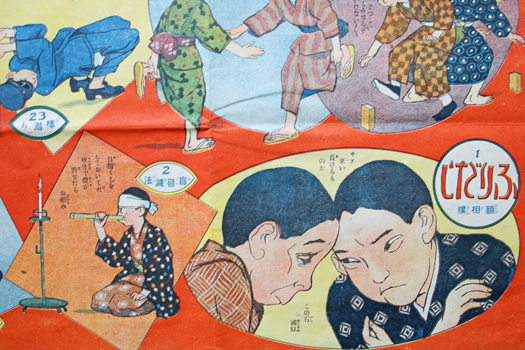
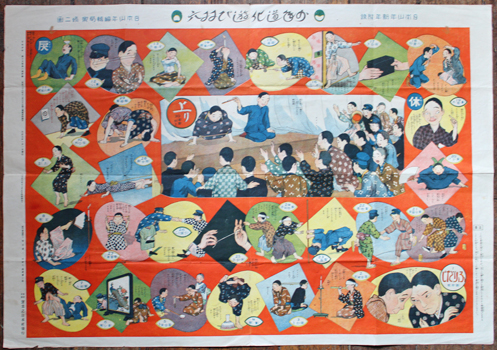
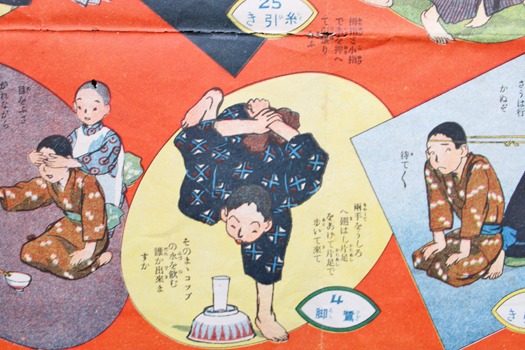
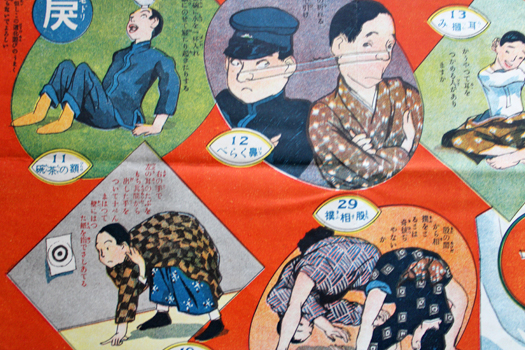

Nakano Shuji. [ ?] [Kao?] [Doke Asobi Sugoroku]. Tokyo, Nihon Shonen 1920 (Taisho 9). 55x79cm colour broadside. Signs of use: some brown spots, small holes in folds. Au$150
I'm baffled by the first two characters in the title. I find that most references transcribe them as 日本 (Nihon - Japan) or 少年 (shonen - boy) and I don't know why, since that's the source, not the title. Only one gives us かお (Kao - face) which bears some resemblance to the actual characters but really doesn't seem satisfactory.
Anyway, this a game of boys' games - games that involve physical antics and clowning such as forehead wrestling - and was the new year gift from the magazine Nihon Shonen and you know how that translates if you've been paying attention.
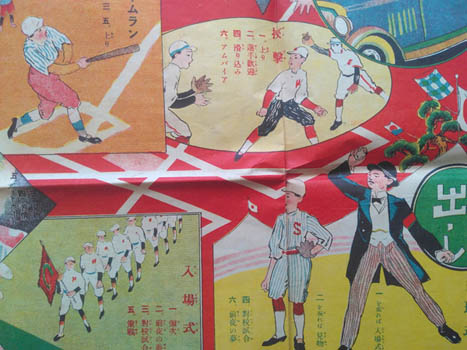
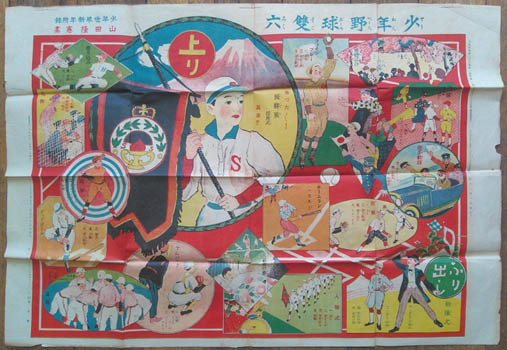
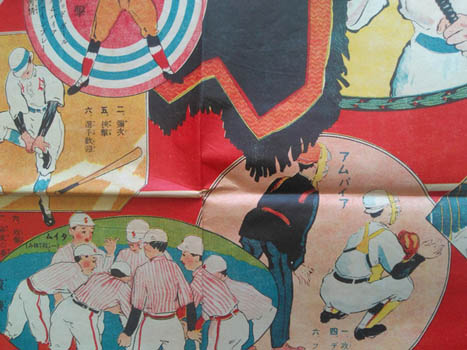
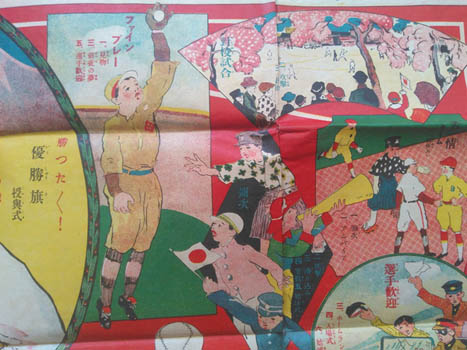

Yamada Takanori. [Shonen Yakyu Sugoroku]. Tokyo, Shonen Sekai 1921 (Taisho 10). Colour broadside 55x79cm. Used, a bit rumpled and browned with some short tears and a small chip in the margin. This is - some mitigation - an untrimmed copy with ample margins and trim marks in the top margin. Not bad. Au$500
An early and rare baseball sugoroku, this was the new year gift from the boys' magazine Shonen Sekai. There is an earlier Japanese baseball paper game (新案 室内ベースボール 1907) but it's not exciting - a simple baseball diamond within a decorative border - and I haven't yet found an earlier sugoroku devoted to it.
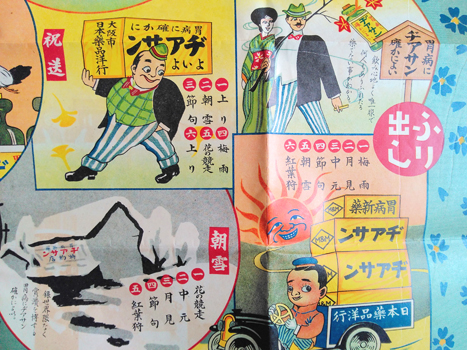
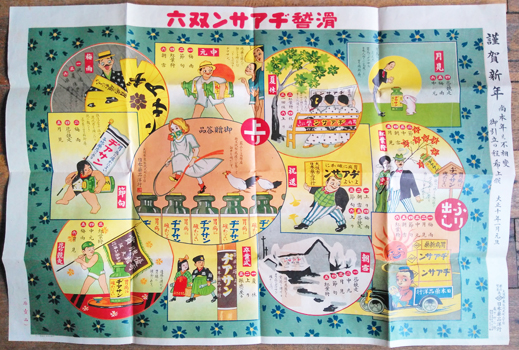
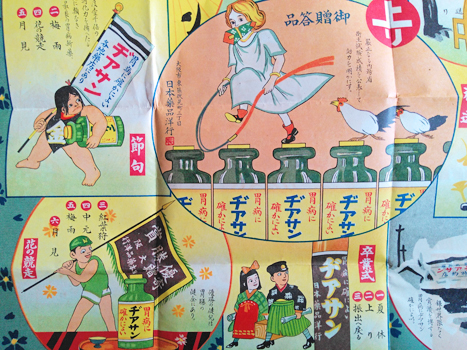
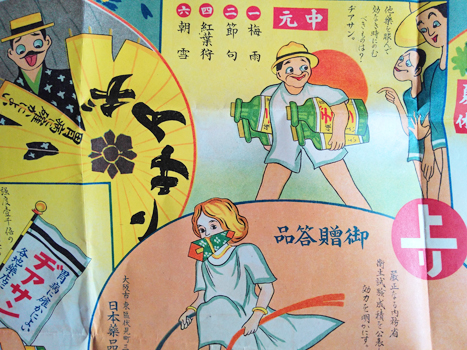

Sugoroku. [Diasan Sugoroku]. Osaka, Morishita 1921 (Taisho 10) Colour broadside 54x78cm. A nice copy. Au$450
A rare and cheerful promotional game for New Year from a friendly drug company. I don't know exactly what Diasan did - it was some kind of digestive - but it clearly made you healthy and happy.
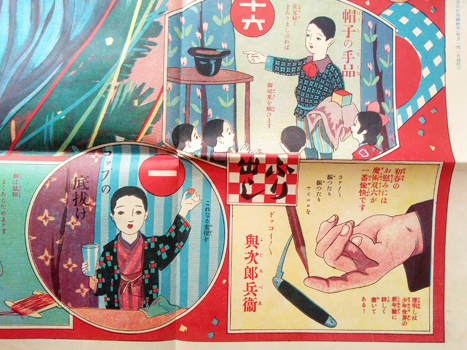
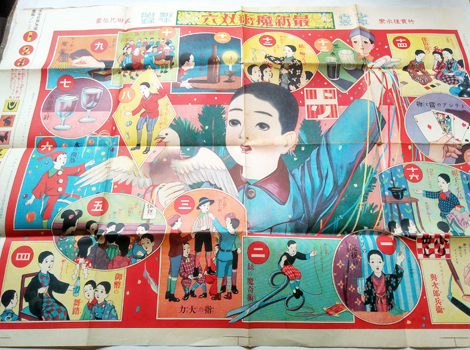
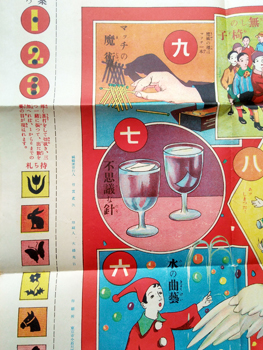
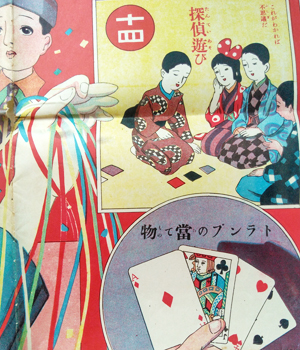

Takeda Hisa. [Saishin Majutsu Sugoroku]. Tokyo, Shonen Sekai 1922 (Taisho 11). 55x80cm colour broadside. Some small holes in folds; with the playing pieces intact in the margin plus the new year issue of Shonen Sekai that this game came with (spine separating but all there and decent enough). Au$300
This game of the latest in magic was the new year gift for 1922 readers.
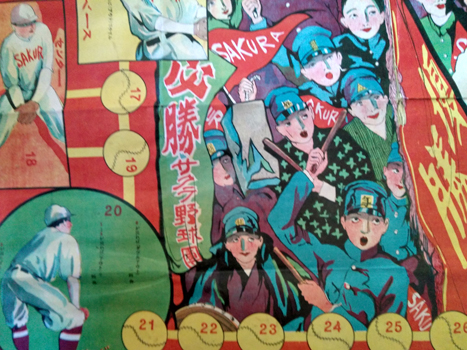
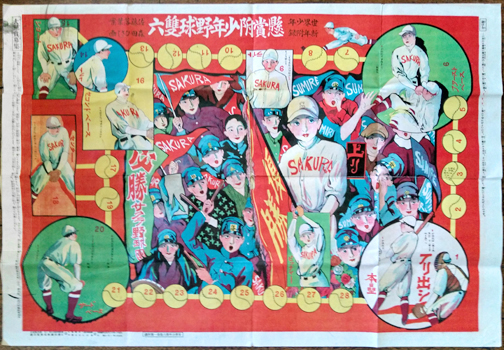
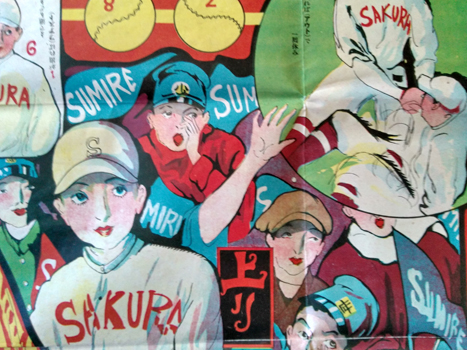
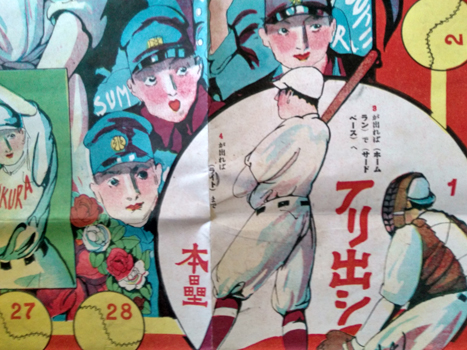

Morita Hisashi. [Kensho Tsuki Shonen Yakyu Sugoroku]. Tokyo, Sekai Shonen 1923 (Taisho 12). Colour broadside 55x79cm. Signs of use: a couple of small holes in folds and ink blotches. Au$350
An early baseball game. Baseball made cameo appearances in earlier games devoted to sport but the earliest all baseball sugoroku I've so far seen was the 1921 new year sugoroku also produced by the boy's magazine Shonen Sekai. Clearly it was a hit - this was the new year gift only two years later.
Morita was a busy illustrator and art director for the Takarazuka Revue through the twenties.
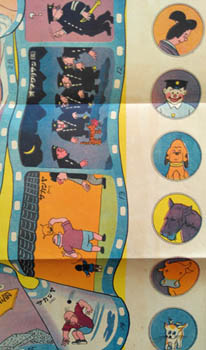
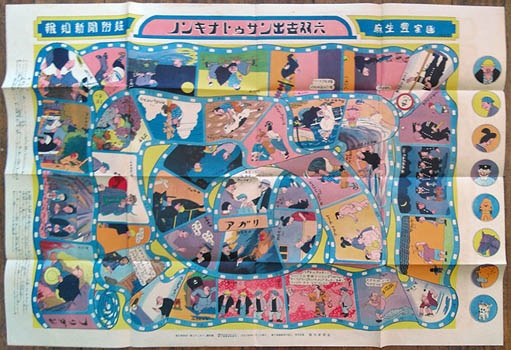
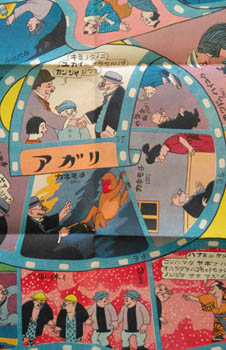
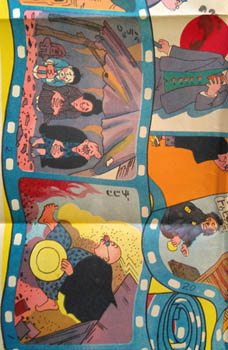

Aso Yutaka. [Nonki Na Tosan de Kichi Sugoroku]. Tokyo, Hochi Shinbunsha 1925 (Taisho 14). Colour illustrated broadside game (54x79cm). Folded as issued, mild signs of use and browning. With the circular portraits of the characters down the side to be cut out and used as game pieces. Au$475
The new year extra from the newspaper Hochi Shinbun starring Japan's first serial comic strip hero Nonki Na Tosan - usually translated as Easy-going or Lazy Daddy - who first appeared in regular comic strips in the paper the year before. He owed some debt to Jiggs of Bringing Up Father but uncle Nonto was a thoroughly Japanese scapegrace and loafer who quickly made his way into games, toys and, in 1925, a short animated film. Now our game is presented as a film while the information I've found about the film, and all the toys, suggests that they were piracies; comic characters were not protected by copyright. Perhaps an all round notion that popular comic strips and film are natural partners explains what may or may not be a coincidence.
This may be Nonto's first sugoroku but it certainly wasn't his last. Come the early thirties as the manga craze blossomed our hero was often teamed with Mickey Mouse and Betty Boop - something of a holy trinity. As said, uncle Nonto is a loafer and this game follows him through a series of disastrous attempts at holding down a job.
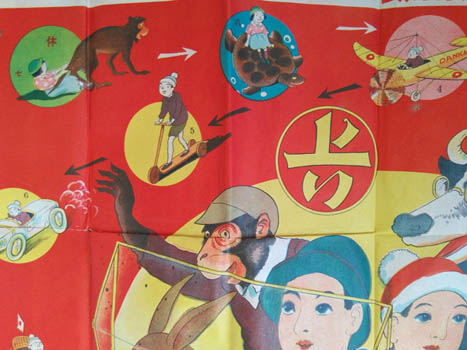
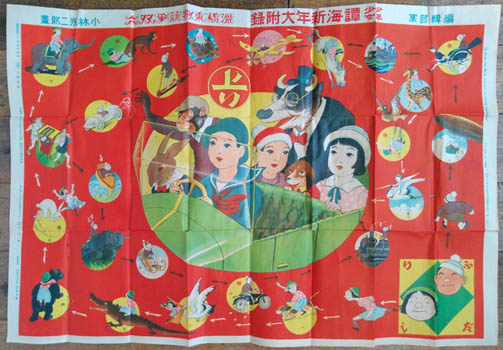
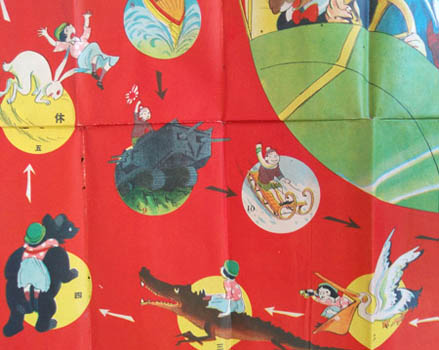
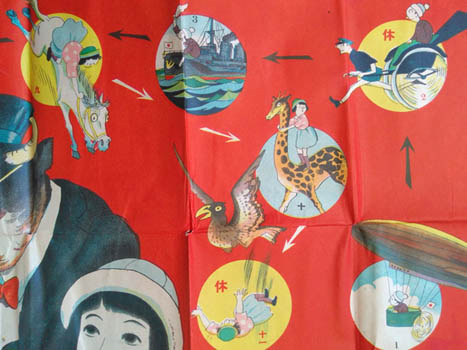

Kobayashi Eijiro. [Kokkei Norimono Sugoroku] Tokyo, Shonen - Shojo Tankai 1925 (Taisho 14). Colour broadside 54x78cm. Small holes in a couple of folds. Au$300
A vivid fun race through all the kinds of transport there are, from monkey's tail or airship to chauffeur driven motorcar. This seems to have been a bilateral new year gift to the readers of the boys' and the girls' Tankai - magazines that ran for decades from 1920 with a name change to Science and Defence during the war years.
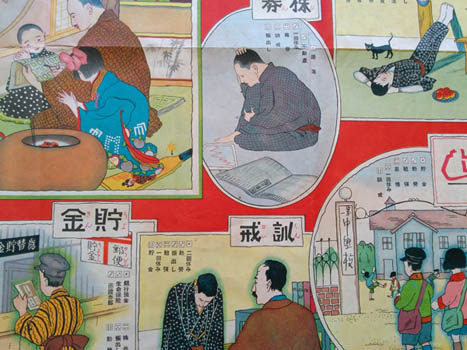
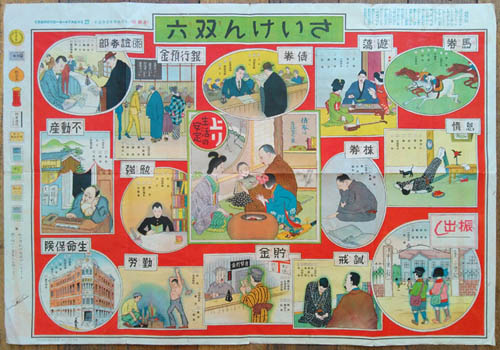
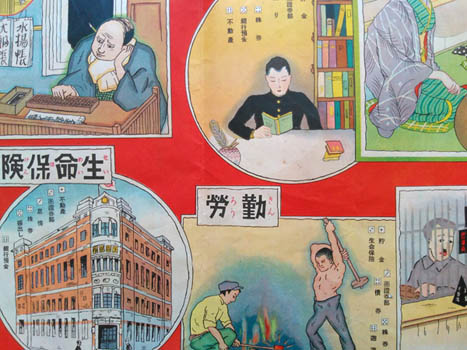
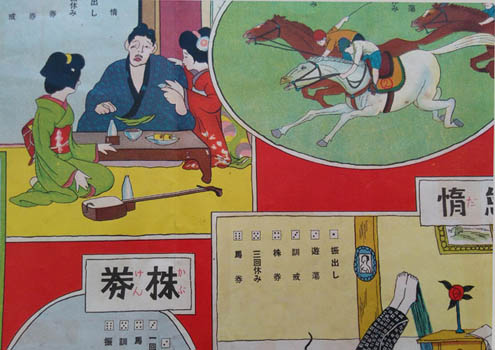

Sugoroku. [Saiken Sugoroku]. Tokyo, Fujimoto Corporation 1925 (Taisho 14). Colour broadside 78x53cm. Used, rumpled and a couple of short marginal tears repaired but very decent. With the playing pieces in the margin. Au$300
A graphic serenade to the virtues of thrift, saving and buying bonds, this was produced by the broking firm Fujimoto for their customers and is labelled 'Not For Sale'. Luckily for the artist and for us some cautionary vices were allowed to spice up a staid game: wine, women and the ponies.
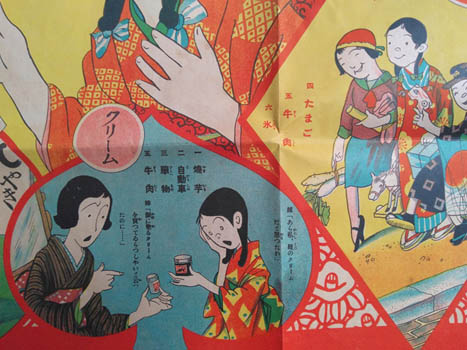
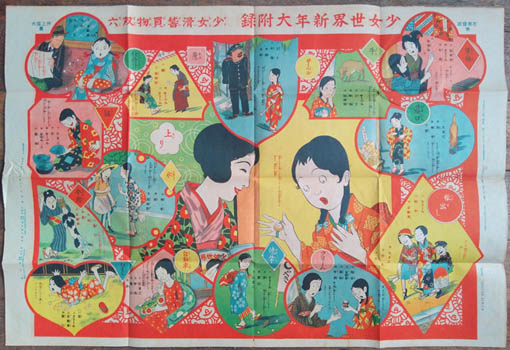
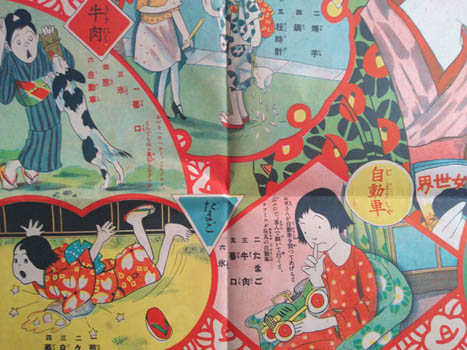
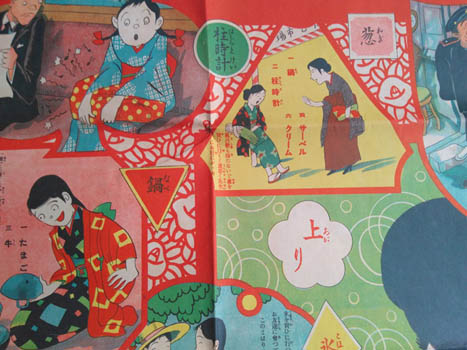

Takeo Inoue. [Shojo Kokkei Kaimono Sugoroku]. Tokyo, Shojo Sekai 1925 (Taisho 14). Colour broadside 54x79cm. Signs of use with a couple of small holes in folds and a neat inscription on the back. Not bad. Au$300
Who said that a girl's life could be dull? Here are just some of the perils and joys of shopping. This was the new year gift from the magazine Shojo Sekai - Girl's World.
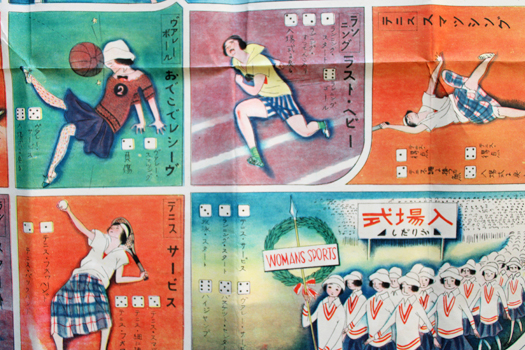
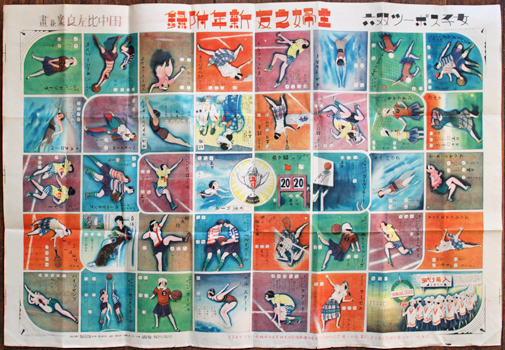
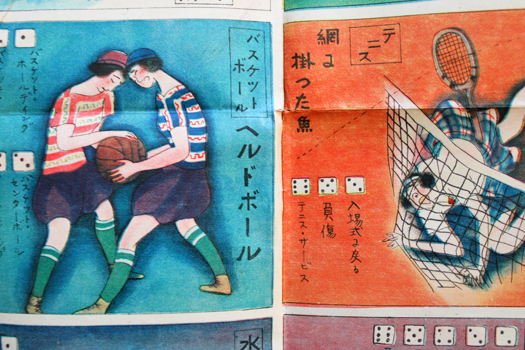
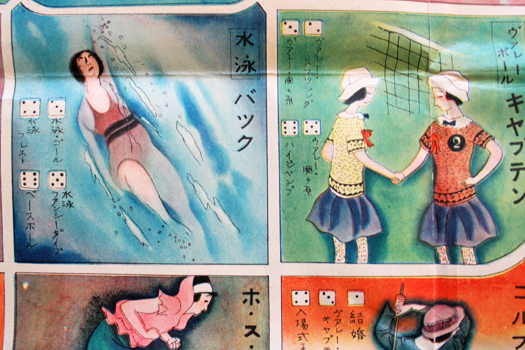

Tanaka Hisara. [Joshi Supotsu Sugoroku]. Shufunotomo 1925 (Taisho 14). colour broadside 95x64cm. Small tears around the edges; pretty good. Au$325
This extra large and stylish manga game was the new year gift from the magazine Shufunotomo - housewife's friend. There's something not often seen here: girls being strenuous and competitive to the point of sweating. Recurring through the game is a fierce battle between two girls, one in red stripes and one in blue. Along the way they shake hands. Those are patterned stockings, by the way, not a skin disease.
Tanaka was a specialist in moga - modern girls - through the twenties.
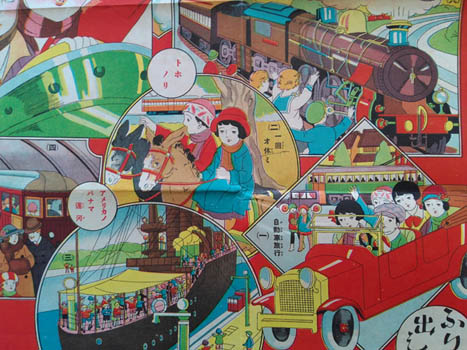
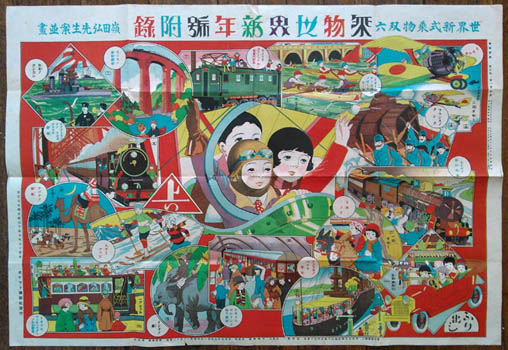
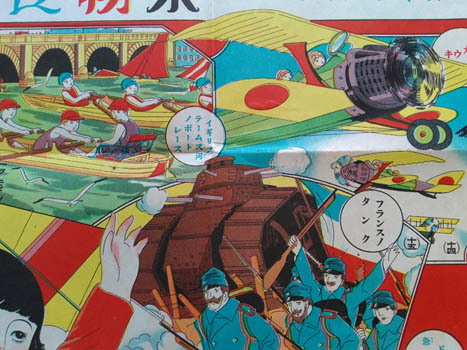
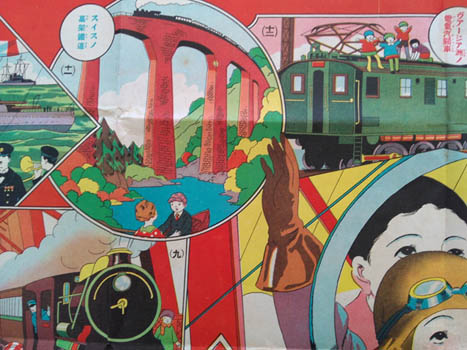

Mineda Hiroshi. [Sekai Shingata Norimono Sugoroku]. Tokyo, Kodansha 1926 (Taisho 15). Colour broadside, 55x79. Mildly used, a short tear repaired and a nick in the bottom margin; pretty good. Au$350
In this new year gift game the kids already have the glazed faces of over privileged world travellers. The only time they show excitement is when defying death by riding on top of an electric train.
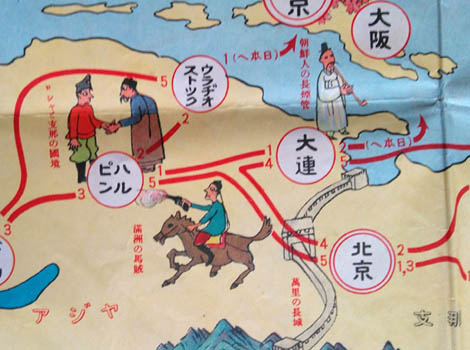
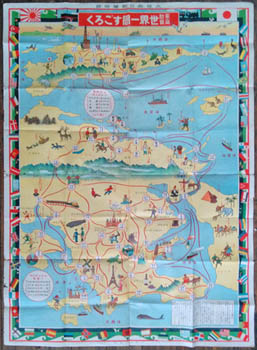
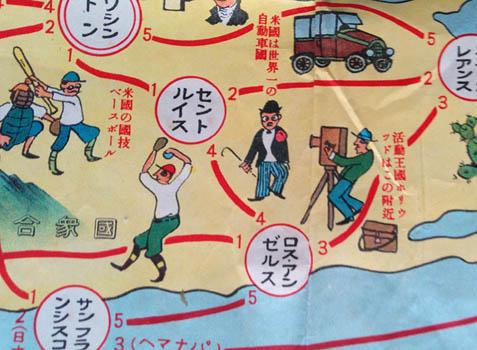
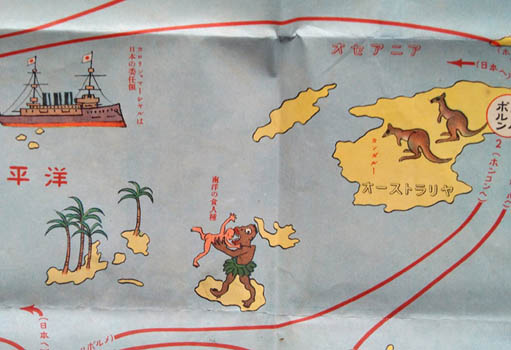

Sugoroku. [Katei Kyoiku Sekai Isshu Sugoroku]. Osaka Mainichi Shimbun, 1926 (Taisho 15). Colour printed broadside 109x80cm. Short tears in the margins and small holes; used but not bad for a particularly large and vulnerable sugoroku. Au$300
It took me a few moments of slackjawed wonder before I realised this is a world map turned sideways and sat on. From where in space did the artist choose their viewpoint, unpeel the globe and spread it out flat? This a self titled educational game for the family. What does it teach us about our place on the planet and relationship to each other? Maybe that all maps are fiction. The Japanese flag flying in the Canadian Rockies marks the first ascent of Mount Alberta by the Japanese Alpine Club in 1925.
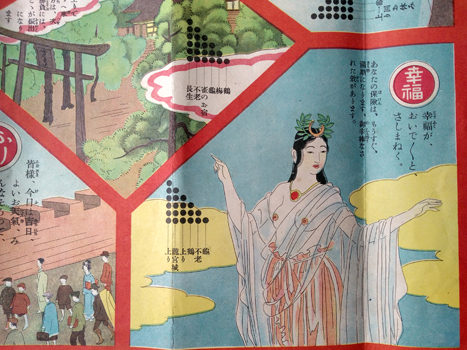
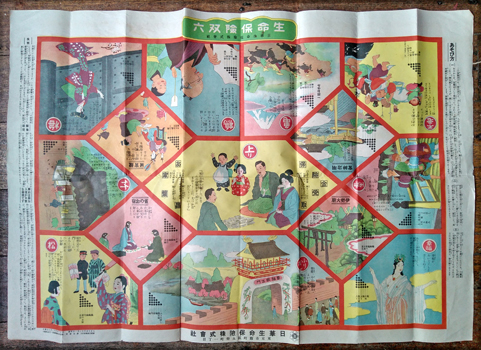
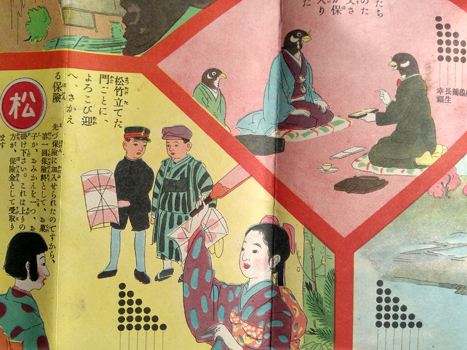
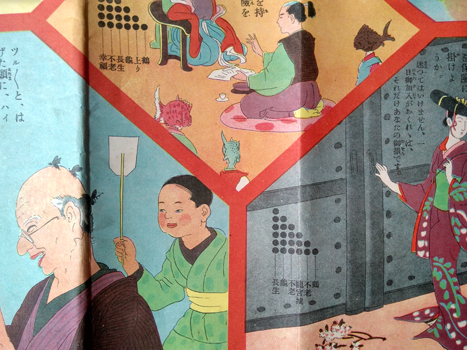

Insurance sugoroku. [Seimei Hoken Sugoroku]. Tokyo, Nikka Life Insurance 1926 (Taisho 15). Colour broadside 54x79cm. Minor signs of use and a little browning, quite good. Au$200
The thrills of life insurance captured in this rollicking game. This should not be confused with the game with the same title issued by the Aikoku Life Insurance company the following year. No doubt that has its charms, but ...
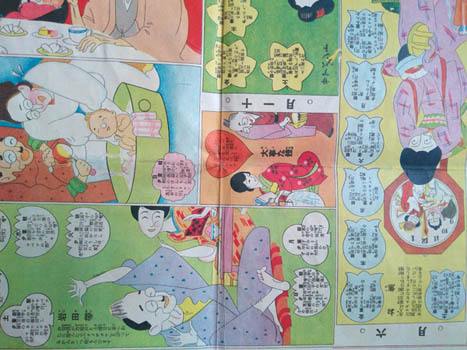
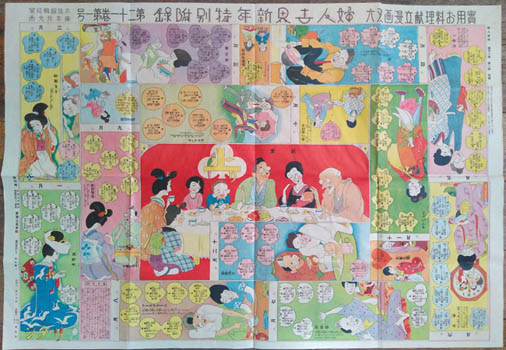
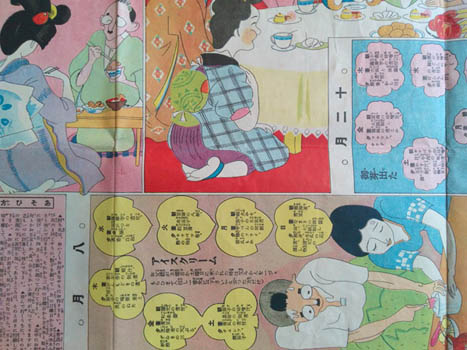
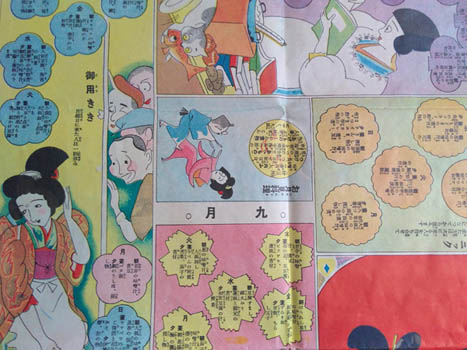

Fujimoto Katao. [Jitsuyo Oryori Kondate Manga Sugoroku]. Tokyo, Fujin Sekai 1926 (Taisho 15). Colour broadside 55x79cm. Mildly used, quite a good copy. Au$500
This delightful manga sugoroku celebrates cooking and was the new year gift from the magazine Woman's World.
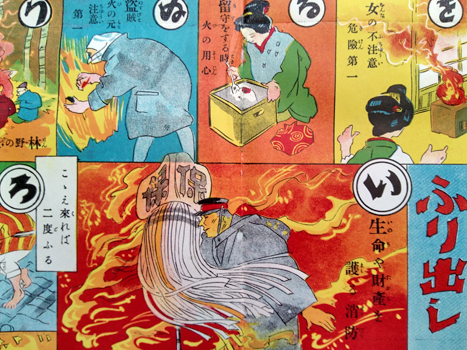
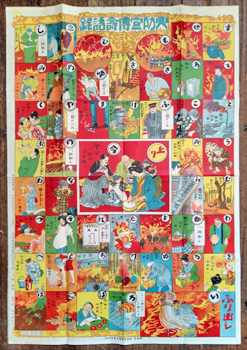
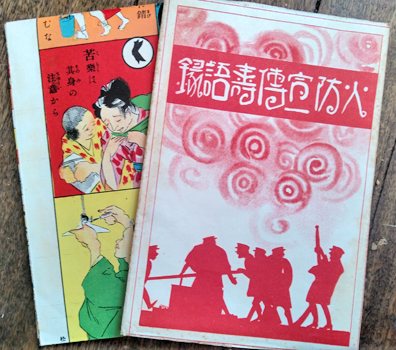
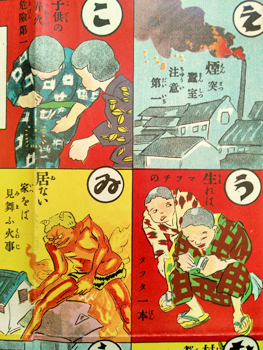

Fire sugoroku. [Hifuse Senden Kotobuki Goroku]. Nagano Prefecture, Hofukujimachi Shobo-gumi 1926 (Taisho 15). Colour broadside 80x55cm. A rather good copy with its original illustrated outer wrapper. Au$750
A thrilling, vivid and rare game, bristling with peril and disaster, issued by the Hofukujimachi fire fighting department. I have seen a ragged copy of this for sale once but I haven't found a record of another copy anywhere.
  1 [2] 3 4 1 [2] 3 4   |